Recently, over at Chronicles of a Game Master, we talked about house rules. It got me thinking, and I finally wrote down my existing and planned house rules. I’m sharing it with you fine folks so that you may benefit from my genius. Or something.
I particularly like the Alchemical Item rules, but I think they’re a bit rough; hit me up if you have comments/critiques/suggestions!
ON WITH THE SHOW!
Ability Generation:
Standard Point Buy.
Alchemical items:

The following rules apply:
Alchemical items now fall under a new proficiency category: Splash Weapons. Splash Weapons have a no proficiency bonus to attack, and do not count as weapons OR implements for the purposes of powers or feats. All classes are considered proficient with Splash Weapons.
If you have the Alchemist feat, you gain a +1/tier feat bonus on attacks with Splash Weapons.
In the item description, get rid of all +X vs Defense numbers; use your highest ability modifier to attack vs the defense specified (fort, ref or will). Area, effects, etc remain the same; damage is now 1dX per “Plus” of the item.
Example:
Alchemist’s Essence Level 1+ Common
When this flask is shattered, its contents fill an area with a deadly distilled element.
| Lvl 1 |
|
20 gp |
|
Lvl 16 |
|
1,800 gp |
| Lvl 6 |
|
75 gp |
|
Lvl 21 |
|
9,000 gp |
| Lvl 11 |
|
350 gp |
|
Lvl 26 |
|
45,000 gp |
Alchemical Item: Volatile Formula Cost: 70 gp
Key Skill: Arcana or Thievery Time: 30 min.
Special: When this item is created, the alchemist chooses acid, cold, fire, lightning, or poison. The item gains that keyword, and all damage dealt by the item is of that damage type.
 Attack Power (Splash Weapon, Varies)
Attack Power (Splash Weapon, Varies)  Consumable (Standard Action)
Consumable (Standard Action)
Attack: Area burst 1 within 10 (creatures in the burst); highest ability modifier vs. Reflex
Hit: The target takes 1d6 damage of the chosen type.
Level 6: 2d6 damage of the chosen type.
Level 11: 3d6 damage of the chosen type.
Level 16: 4d6 damage of the chosen type.
Level 21: 5d6 damage of the chosen type.
Level 26: 6d6 damage of the chosen type.
Miss: Half damage.
Goal: this is a bit rough, but the idea is to make Alchemy more practical and effective. Note that since Alchemical items are now Splash Weapons, the enhancement bonus from the Inherent Bonus system apply, which should keep accuracy where it needs to be.
Backgrounds and Themes:
You may select one Theme at character creation.
You may select any number of backgrounds, but you only receive the benefit of one of them.
Your theme and backgrounds should mesh. Use this as a way of establishing your character’s backstory and relationship with the world.
Custom themes are allowed, see me if you wish to create/modify a theme.
I reserve the right to modify or deny a theme if it doesn’t fit the campaign setting or story.
Bonus Feats:
 All characters receive Versatile Expertise TWICE for free at level 1. This should cover a decent range or ALL proficiencies the character has, allowing you to be effective with a range of magic weapons/implements (in case you don’t get exactly what you want). This is mostly for the character builder’s benefit.
All characters receive Versatile Expertise TWICE for free at level 1. This should cover a decent range or ALL proficiencies the character has, allowing you to be effective with a range of magic weapons/implements (in case you don’t get exactly what you want). This is mostly for the character builder’s benefit.
At 11th level, you receive Paragon Defenses for free.
At 21st level, replace Paragon Defenses with Robust Defenses.
Int 15+: receive Linguist free.
Logic: the idea here is to cover for a math error in the rules (players end up about 3 points shy of where they should be, attack bonus wise, over the course of the game; and player defenses end up a bit too low to be any use against monster attacks) w/out making the players sacrifice feats for it. Since all the players I know would take these feats if they didn’t get them anyway, it seems reasonable to give them out for free and open up some space for something more interesting.
Note that I didn’t just say “Free Expertise Feat.” The Essentials line (with Heroes of the Fallen Kingdoms, I think) started introducing expertise feats that had an additional benefit (such as ignoring all cover) on top of the math patch. These feats are strong enough to survive on their own sans +to hit, so I think it’s a bit too powerful to give them out for free (especially since the idea here is to cover for a math error). Players can still take them if they want and get the benefit with that specific weapon/implement group.
Free Linguist at Int 15+ is a nod at 3rd edition (where you got bonus languages based on Intelligence). Besides, who takes Linguist?
Free cookie to anyone who has actually taken this feat for a character.
Dice Rolls:
All rolls of the dice must be made on the table (if playing in person). Any dice that rolls off the table must be re-rolled. Any dice that rolls onto a “crack” or otherwise does not end up flat must be re-rolled.
GM Dice Rolls: players decide before game starts if the I roll the dice behind a screen or out in the open. This decision can be changed down the line if a majority of players wish it so. If I am rolling behind a screen I reserve the right to “fudge” rolls as I see fit.
Special Exceptions: Unless specifically voted otherwise, some rolls will be made by me and ALWAYS be made behind the screen (sense motive, disguise, forgery checks, bluffs, some perception rolls, etc). This is to prevent metagaming (not because it’s “cheating” but because it can break immersion or kill the tension).
Inherent Bonuses:
As per the DMG2/Dark Sun. Gist: characters receive inherent bonuses to attack/defense at set levels; magic items are thus not necessary to keep pace.
Racial/Theme Powers:
Any power without an implement or weapon keyword and that has +2/+4/+6 listed for attack bonuses now lists +3/+6/+9 instead.
Reason: along with the free expertise feats, this is designed to bring the game math in line with “projected” numbers, keeping everything at the right accuracy. Since these powers don’t get feat bonuses from expertise feats, the math has to be adjusted.
Magic Items:
No restriction on Daily Magic Item use. Each item can still only be used once before your next extended rest, but you can use 5 separate items in one day if you want (and if you have 5 items with daily activations).
Sources Allowed:
Anything in the Compendium is allowed. If you prefer a non-errated version of a power or class or ability, talk to me; I have a lot of the books.
Example: you prefer the pre-Essentials Magic Missile power; I’m fine with that.
Logic: my players like options, and I like variety 🙂 I also don’t always agree with the errata bat.
So there you have it! My house rules for 4e. Pretty basic stuff, really, and I’m curious to see how it stacks up all together in game. I’m also curious to know if any of the space cadets out there have used any of these rules, and care to share their experiences. Comment below!
Note: Alchemists Essence ©Wizards of the Coast 2011, from the book Mordenkainen’s Magnificent Emporium.


 The Drinking Room is accessible via stairs up from the cistern area, or by one of two long tunnels from the Reeking Dens. It is a simple open cavern featuring a stone table, a chicken coop, and a volatile looking still.
The Drinking Room is accessible via stairs up from the cistern area, or by one of two long tunnels from the Reeking Dens. It is a simple open cavern featuring a stone table, a chicken coop, and a volatile looking still.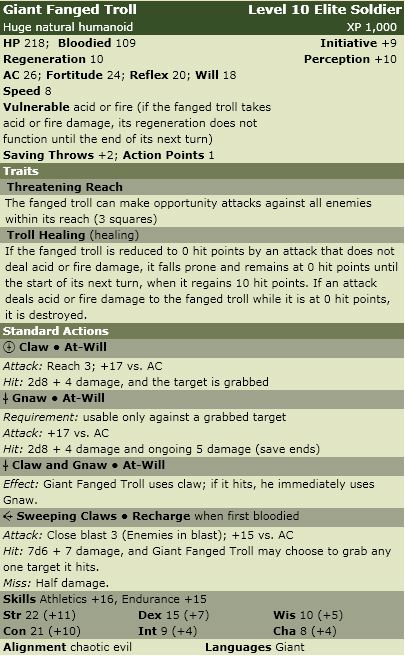
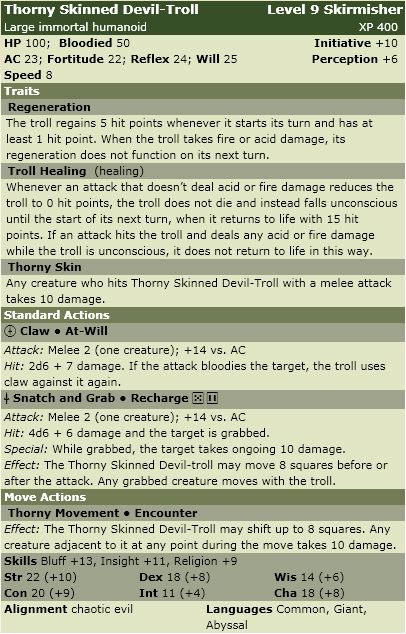
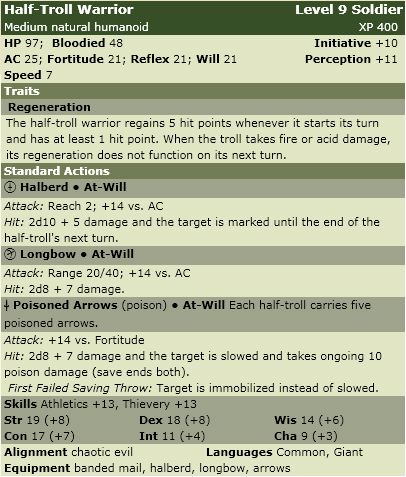
 Meat Hacker Yog (see below) gibbers and slobbers in Giant for his troll assistants to attack. While the troll’s engage in melee, Yog grabs an arbalest and rains fire down from afar. The dire boar charges the softest looking target, hoping to knock it prone and tear into it with his tusks.
Meat Hacker Yog (see below) gibbers and slobbers in Giant for his troll assistants to attack. While the troll’s engage in melee, Yog grabs an arbalest and rains fire down from afar. The dire boar charges the softest looking target, hoping to knock it prone and tear into it with his tusks.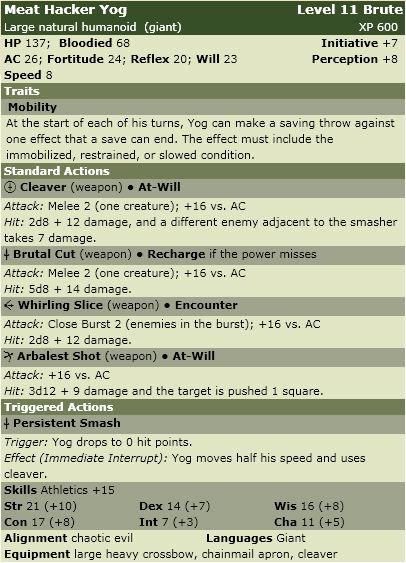
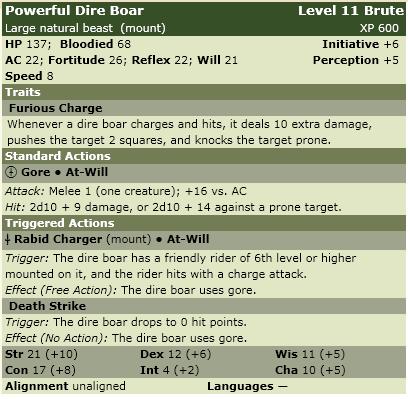

 All characters receive Versatile Expertise TWICE for free at level 1. This should cover a decent range or ALL proficiencies the character has, allowing you to be effective with a range of magic weapons/implements (in case you don’t get exactly what you want). This is mostly for the character builder’s benefit.
All characters receive Versatile Expertise TWICE for free at level 1. This should cover a decent range or ALL proficiencies the character has, allowing you to be effective with a range of magic weapons/implements (in case you don’t get exactly what you want). This is mostly for the character builder’s benefit. If the players came in via the front entrance (encountering
If the players came in via the front entrance (encountering  The drunken troll rushes into combat against the nearest enemy and attacks until that person is dead or not moving, then moves to the next closest person. The drunk troll fights to the death.
The drunken troll rushes into combat against the nearest enemy and attacks until that person is dead or not moving, then moves to the next closest person. The drunk troll fights to the death.
 The common entrance into Vulture’s Crag is an opening along one wall of the mesa, accessible via a narrow path. The path is wide enough to travel safely, and it rises to 50 feet above the tar pits by the entrance.
The common entrance into Vulture’s Crag is an opening along one wall of the mesa, accessible via a narrow path. The path is wide enough to travel safely, and it rises to 50 feet above the tar pits by the entrance.



